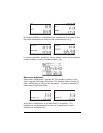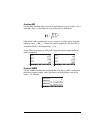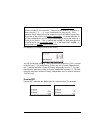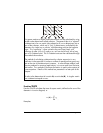
Page 11-10
Function SRAD
Function SRAD determines the Spectral RADius of a matrix, defined as the
largest of the absolute values of its eigenvalues. For example,
Function COND
Function COND determines the condition number of a matrix:
Definition of eigenvalues and eigenvectors of a matrix
The eigenvalues of a square matrix result from the matrix equation A⋅x = λ⋅x.
The values of λ that satisfy the equation are known as the eigenvalues of the
matrix A. The values of x that result from the equation for each value of l are
known as the eigenvectors of the matrix. Further details on calculating
eigenvalues and eigenvectors are presented later in the chapter.
Condition number of a matrix
The condition number of a square non-singular matrix is defined as the product
of the matrix norm times the norm of its inverse, i.e.,
cond(A) = ||A||×||A
-1
||. We will choose as the matrix norm, ||A||, the
maximum of its row norm (RNRM) and column norm (CNRM), while the norm
of the inverse, ||A
-1
||, will be selected as the minimum of its row norm and
column norm. Thus, ||A|| = max(RNRM(A),CNRM(A)), and ||A
-1
|| =
min(RNRM(A
-1
), CNRM(A
-1
)).
The condition number of a singular matrix is infinity. The condition number of
a non-singular matrix is a measure of how close the matrix is to being singular.
The larger the value of the condition number, the closer it is to singularity. (A
singular matrix
is one for which the inverse does not exist).


















